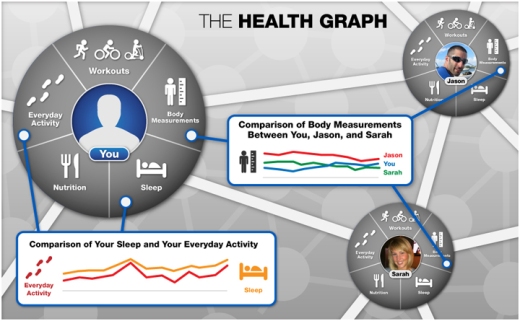It’s been a long time I wanted to write on this topic, and recents discussions at the latest Quantified Self MeetUp in Paris have confirmed that there is a growing interest on business models around apps and services related to quantified self movement.
At a very first level we could identify 3 different patterns : the most classical is of course to produce and sell connected devices or apps ; an intermediate one is about monetizing data analysis and the most innovative and ambitious one is to become the platform.
Runkeeper is obviously following the last one since they announced their strategy aiming at centralizing users data by federating health and fitness apps and devices manufacturers through their health graph API in october 2011.
Through the health graph Runkeeper is trying to solve a classical issue we meet on the web when using several services that are more or less working in silos. This is for example what Mint is doing for personal finance data. In a quantified self perspective overcoming these silos is a real challenge because value comes with the ability to establish correlation between different sets of data. This point is particularly highlighted by Amber Case (@caseorganic) in her intervention at the latest Le Web Conference (11’14).
With publicly available information and from my experience as an intensive user of RunKeeper, I tried to draw the business model linked to the Health Graph using the kit from Board Of Innovation.
The scheme above describes the relationships between Runkeeper and its different customer segments. RunKeeper is often seen first as a free apps to track fitness activities, it’s true, but the apps is actually just a way to gather data. These data are the heart of their business model. As the health graph ambition is to turn Runkeeper into a platform (a kind of Facebook for health data) we find 3 customer segments that form this two-sided market with end-users on the left, and businesses on the right side. (nb: I didn’t map the e-commerce part which may be significant in terms of opening on the ecosystem, but not pioneering in a BM perspective.)
The end-user side is arranged around a freemium model with an « elite status » for paying users which provides access to a more detailed analysis of data and advanced features in the apps. The business side is more complex and also more interesting.
I think that we can at least separate 3 differents kinds of partners in the B2B relationships:
- Health graph partner « data contributor« : they represent the main target: by providing their data, they help at offering a better user experience for end-users, more convenient as all their data are in one single place, and they strengthen the position of RunKeeper as a Platform. Partners like Fitbit or Withings provide data to the Runkeeper health graph and in return earn commissions when their users convert to elite and also have access to the 14 million members of the platform;
- Healt graph partner « value contributor » : Another type of apps that are linked through the healt graph API offer value-added services to end-user based on the analysis of their data. A good example is Earndit , a service that gives rewards based on user activity. Each time a user run, Earndit rewards him with points that can be used among relevant partners;
- Affiliate Partners: This category is different from the two others as it concerns access to aggregated data from the platform. I would point out that there is no specific information on this subject, but the privacy policy leaves the door open to this type of data exchange. We could guess that these data could be used for research purposes, or meaningful for a sports brand that would investigate on the best location to open its future store for example.
What’s interesting with two-sided markets is that the goals of various parties can be more or less aligned. It would be interesting to know the weight of the different segments in the income of RunKeeper, and see how they evolve. At first glance there is a potential tension between users and businesses. As the first will centralize more and more data on the platform, they may be less likely that these personal data are being shared or sold.
Olivier Desbiey


Pingback: Is Runkeeper Hitting The Right Business Model Through Health Graph Strategy ? ← Msante & Quantified Self
Pingback: RunKeeper Jobs and Internships
Pingback: RunKeeper Internships | One Day, One Internship